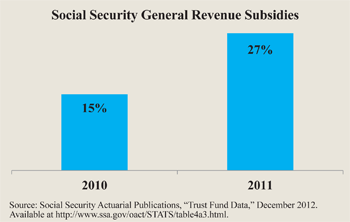In December 2010 President Obama traded Congress a two-year extension of the Bush-era tax cuts for a one-year, 2 percentage-point payroll tax holiday and additional unemployment benefits. The “Temporary Employee Payroll Tax Cut” reduced the employee portion of the Social Security payroll tax from 6.2 percent to 4.2 percent on individual earnings up to the taxable maximum of $110,100.
 In December 2011, Congress extend the payroll tax holiday for two months to prevent a tax increase during the winter recess. In February 2012 the holiday was extended through the end of the year. The payroll tax cut has now been extended twice and is set to last twice as long, if not extended, as initially proposed. What are the effects of this tax cut on consumer spending and long-term debt?
In December 2011, Congress extend the payroll tax holiday for two months to prevent a tax increase during the winter recess. In February 2012 the holiday was extended through the end of the year. The payroll tax cut has now been extended twice and is set to last twice as long, if not extended, as initially proposed. What are the effects of this tax cut on consumer spending and long-term debt?
Impact on Social Security. Payroll taxes are the main source of revenue for Old Age, Survivors and Disability Insurance (OASDI), or Social Security benefits. The unfunded liability of the OASDI program is the difference between the benefits that have been promised to current and future retirees and projected collections of dedicated taxes. As of this year, the unfunded liability into the indefinite future, called the infinite horizon, is $20.5 trillion plus a trust fund debt of $2.5 trillion, according to the Social Security Trustees’ report.
The payroll tax cut has had a negative effect on the annual operations of Social Security. Since its inception it has:
- Reduced Social Security payroll revenues 16 percent; and,
- Decreased revenue $103 billion in 2011 and an estimated $112 billion in 2012.
Though seemingly a drop in the bucket, the payroll tax cut increased Social Security’s real unfunded liability by $215 billion plus interest.
Stimulus versus Debt. The Congressional Budget Office estimates that extending the payroll tax cut and emergency unemployment benefits through 2013 will raise Gross Domestic Product 0.7 percent higher in 2013, and lower unemployment 0.8 percent, compared to a scenario where they expire. The most obvious reason the holiday stimulates the economy is the $100+ billion per year tax cut unaccompanied by any reduction in spending. Instead the holiday was financed by debt, to be paid for by future generations, and is accumulating interest payments now.
The resulting increase in long-term debt could potentially raise interest rates, crowd out private investment and make it harder to pay back the debt in the future by reducing the income (GDP) from which the debt will have to be paid. In the short term, the law requires that the payroll revenue forgone by the holiday be replaced from general revenue. As a result [see the figure]:
- Currently, 27 percent of Social Security revenues come from general government revenue, up from 15 percent in 2010.
- The payroll tax component of Social Security revenue has fallen 10 percent, from $637 billion to $564 billion per year.
- Without funds from general revenue, current benefits could not be paid.
Additionally, Martin Feldstein has found that each dollar of social security benefits reduces personal savings by 60 percent. The reduction in personal savings causes substantial loss of real investment income over a lifetime.
The Future of the Holiday and Social Security. The expiration of the payroll tax holiday offers a chance to reform Social Security benefits by allowing working individuals to prefund some of their Social Security retirement benefits by saving 2 percentage points of their payroll tax liability. If matched by an employer contribution of 2 percent of wages, such partial prefunding could eliminate the unfunded liability of Social Security. PRAs, coupled with progressive indexation of benefits and an increase in the retirement age to account for the increase in longevity, would eventually result in a fully prefunded Social Security program by the time young workers retire midcentury.
First, the payroll tax rate on individual earning should be raised back to 6.2 percent. The elimination of the payroll tax holiday could reduce GDP and increase unemployment in the short term; however, it would help allay investors’ concerns over the increasing costs of capital due to government borrowing. Taxpayers would have the option to put this 2 percent in a personal account invested in stocks and bonds. The investment options could be similar to the Thrift Saving Plan (TSP) administered by the Federal Employees Retirement System; the TSP gives enrolls a choice of 10 funds tracking various indices. The accrual of Social Security benefits for workers who invest in a PRA would be reduced, and the benefit reductions would be offset by the accumulated savings in the PRA.
Second, the total benefit offered should be progressively indexed. Indexing would reduce benefits for those with higher incomes, leaving benefits for workers with low lifetime incomes the same. High income earners who contribute more would still receive more benefits, but not as much as currently scheduled. Lowering scheduled benefits is a vital part of cutting the unfunded liability.
Conclusion. While a payroll tax holiday could provide temporary stimulus during an economic slump, it further erodes the relationship between Social Security’s revenue, individual earnings and benefit payments while increasing debt. Instead of simply raising rates again this opportunity should be taken to reform Social Security.
Lewis Warne is a research associate with the National Center for Policy Analysis.